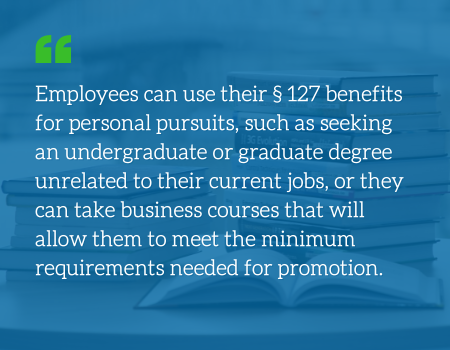Two ways to square educational assistance benefits with the tax code
 Employees are quitting jobs at an alarming rate. Some pundits are calling this the Great Resignation. Since we can’t think of anything cleverer, we’ll stick with it. Unfortunately for businesses, hiring is both exhausting and expensive. In fact, it’s much cheaper to keep employees than it is to find new ones.
Employees are quitting jobs at an alarming rate. Some pundits are calling this the Great Resignation. Since we can’t think of anything cleverer, we’ll stick with it. Unfortunately for businesses, hiring is both exhausting and expensive. In fact, it’s much cheaper to keep employees than it is to find new ones.
In such a seller’s market, how do you retain employees and keep them motivated? One option to consider is amping up your perks to provide educational assistance benefits. This can be an enticing benefit for new and existing employees. Educational assistance will also benefit employees who’ve been on long furloughs and need to polish up their skills.
If you’re considering setting your business apart in this way, the tax code gives you two ways to approach it — an easy way and a hard way.
The easy way
IRC § 127 allows you to provide up to $5,250 a year to employees in tax-free educational assistance benefits, with few strings attached.
Your educational assistance program must be a separate written plan and meet these requirements:
- It benefits employees who qualify under the rules you set up.
- Your rules can’t favor highly compensated employees.
- The program doesn’t provide more than 5% of its benefits to shareholders or owners, or their spouses or dependents.
- Employees can’t choose to receive cash or other taxable benefits instead of educational assistance. In other words, you can’t offer this program through your cafeteria plan.
- You give reasonable notice of the program to eligible employees.
- Employees substantiate their expenses to you.
Your plan can be as broad or as narrow as you choose. Employees can use their § 127 benefits for personal pursuits, such as seeking an undergraduate or graduate degree unrelated to their current jobs, or they can take business courses that will allow them to meet the minimum requirements needed for promotion.
Limit #1: You generally can’t pay for or reimburse employees for courses considered sports, games, or hobbies.
Limit #2: If you’re already picking up some of the employees’ student loan expenses, you must subtract the amount you’re picking up from employees’ current educational assistance entitlement.
The hard way
If you don’t want to be bothered with monetary caps, IRC § 162 allows you to pick up or reimburse 100% of employees’ job-related educational expenses. This type of education allows employees to maintain or improve their current skills, without qualifying them for new jobs. It also includes education required by law or by you.
Why is this the hard way? Because the trick is having educational expenses qualify for tax-free treatment in the first place. Since going to school is inherently personal, the IRS interprets this section of the tax code very narrowly. For example, you can never pay for expenses associated with undergraduate degrees; graduate school expenses fare a bit better.
Example. David performs sales, marketing, and management duties for Sparky. He continues to do so while he’s in graduate school for his MBA and after he receives his degree. Sparky can exclude these expenses from David’s income because receiving an MBA isn’t a precondition to him performing his current job. While the MBA improves his business, marketing, and sales skills, it doesn’t qualify him to perform tasks and activities that are significantly different from those he could perform before the MBA.
Also, the IRS’ logic is circular. So you can pay for courses employees need to maintain or improve their current skills, but you can’t exclude those expenses from employees’ income if the education allows them to meet the minimum requirements of their current jobs or qualifies them for new jobs, even if, at the same time, the education maintains or improves the skills employees currently need.
Could vs. intend: To determine whether a course qualifies an employee for a new trade or business, look at what they could do with their newly acquired knowledge, rather than what they intend to do. If the education qualifies an employee to perform significantly different tasks and activities from those they could perform before, the education qualifies them for a new trade or business.
Bottom line: Because qualifying for tax-free treatment under IRC § 162 is dicey, outlays for job-related educational assistance should be limited to seminars or refresher courses.






